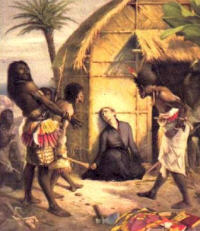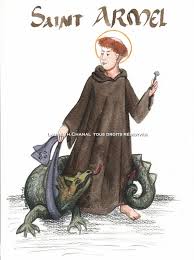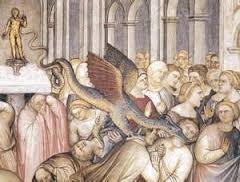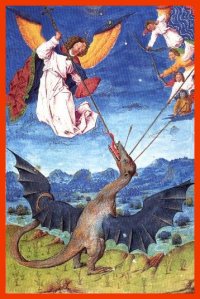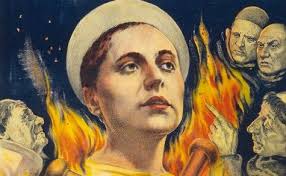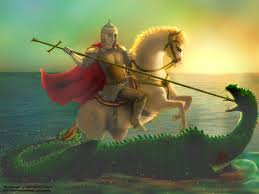
St. George Patron of England, Knights, Archers; Invoked against Plague, Leprosy, Syphilis
George was a Palestinian soldier martyred during the persecution of Diocletian; his cult flourished not only in the Middle Easts but in England during the Crusades—it was probably the Crusaders who brought it with them from Palestine. King Edward III made George Patron of England and Henry V invoked him a the Battle of Agincourt. The story of George and the dragon—the triumph of good over evil—varies. In the classic version, George, young and handsome confronts the dragon-with-poisonous-breath who is holding a princess captive. (She drew a short straw in the town lottery and/or was perishing in a castle from lack of water.) George pierced the dragon with his lance, led it captive through town in the princess’s girdle, and instantly converts 15,000 people. In the East, George is depicted as a quasi-god who endures a series of tortures, including running in red-hot shoes, but always miraculously recovers the next day. In the Western version, George is a prince of Cappadocia who is tortured daily for seven years and whose bravery is so great that he converts 40,900 people, including the Empress Alexandria. An ignoble George does exist, however: in Gibbon’s Decline and Fall, which portrays him as a brigand dealing in black-market bacon and rising to power as a Primate of Egypt. This George was arrested and thrown into the sea. In art, George is depicted dressed in armor, carrying a banner with a red cross, and slaying the dragon. The British flag, the Union Jack, includes a variation of the red cross of Saint George. “Riding Saint George”—that is, sexual intercourse with the female on top—was long believed to be the certain method of begetting a bishop.
